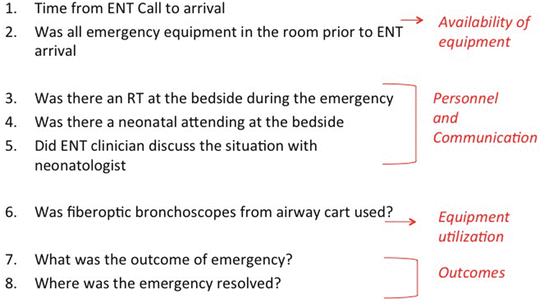Fig. 1
Organizational system chart showing components of a successful airway safety program. People, process, and tools make up the system
For the program to succeed, those taking care of the patients must believe in the program’s mission and support the methods of its execution. Establishing a decision-making team of six to eight members that represents the gamut of provider types is recommended. This team can reach out to a larger frontline provider group through focus groups and brainstorming sessions [9].
Providing effective avenues for stakeholders to communicate with one another is critical [10]. For example, how will a neonatologist caring for the patient know what the surgeon’s concerns are in the postoperative period? How will the overnight nurse inform the morning medical team that they had issues with the airway’s security? How will the team ensure that important information on the patient is passed off accurately and completely from shift to shift? From a patient handoff standpoint, the most effective communication mode is live, person-to-person while the least effective is a written note. The choice of using live (in person, phone call, video conferencing) and non-live (email, text messaging) methods depend on (1) the information to be communicated, (2) urgency, (3) whether a response is required and how quickly, (4) number of people/disciplines involved, and (5) whether the team can overcome competing processes that prevent live communication. Periodic monitoring of how well the team is communicating is critical because the contextual environment is not static and frequently can introduce process changes that impact communication. For example, if the surgeons are doing more cases, they may be more absent in postoperative handoffs. If the N/IICU adds more beds and expand location, the emergency airway response process will likely need to accommodate the geographical challenges. As the patient census grows and the unit becomes busier, safety rounds may need to happen more frequently and require more leaders to participate (Fig. 1).
Identifying actionable, meaningful data directly related to the active improvement efforts is critical. Allowing important (but extraneous to the effort) metrics to “scope creep” into the monitoring process is discouraged. Regular review of all emergency airway calls can reveal insights into system vulnerabilities often missed with surveys and questionnaires. Furthermore, data must be collected in a manner that is capable of reflecting whether improvements in processes ensure safety. Importantly, monitoring outcome and process metrics at frequent intervals over a wider range of scenarios is more useful that collecting numerous amount of data in one scenario.
Supporting the above operations systems, we describe an airway safety program, centered on airway emergency response protocol, effective perioperative communications, and weekly multidisciplinary rounds.
Improving Airway Emergency Response
Safety and efficacy in response to airway emergencies are critical to the success of any airway program. As such, quality improvement relies heavily on the ability to identify the deficiencies in safety and efficacy of emergency responses. Upon activation of an advanced airway response, the respiratory therapist brings a critical airway emergency cart containing a flexible fiber optic bronchoscope, a video laryngoscope, and other emergency anesthesia and surgical airway equipment to the bedside. At the end of the event, the respiratory therapist completes a questionnaire documenting the type of airway, nature of emergency, time to response, interdisciplinary communication, use of emergency airway equipment including the use of flexible bronchoscope and the final disposition (Fig. 2).


Fig. 2
Emergency airway tracking sheet to be used as a tool to gather information at each airway emergency and create QI metrics for improvement. (Courtesy of Neonatal Airway Program, The Children’s Hospital of Philadelphia)
To provide an example of the application of these initiatives, in-house data collected since the beginning of the Children’s Hospital of Philadelphia QI program was reviewed retrospectively. Airway emergency response was activated more than 120 times since the start of the program. The average response time was 5.5 min (±3.1 min); critical airway emergency cart was at the bedside 100 % of the times. Otolaryngologists identified themselves to the other caregivers > 85 % of the times. Interdisciplinary communication between the otolaryngologist and neonatologist was noted in >92 % of all instances. Flexible laryngoscope was used in 78 % of all instances. 2.8 mm laryngoscope was used in 60 % of cases, whereas 2.2 mm laryngoscope was used in 40 % of cases. Majority of the airway emergencies (>97 %) were resolved by repeat tracheal intubation (>98 %) via use of either Miller laryngoscope (>60 %) or Benjamin laryngoscope (<35 %). Most (98 %) of airway emergencies were resolved in the N/IICU, whereas <2 % were resolved in the operating room. A multidisciplinary airway emergency response program can improve the quality of care in a cost-effective manner by improving both the response time, time to tracheostomy, duration of procedure and post-procedural intensive care unit stay.
Improving Perioperative Communications
Poor perioperative communication affects medical decision-making, patient safety, and productivity and invariably leads to surgical delays, patient inconvenience and, sometimes, serious errors. Recent specialization of otorhinolaryngology surgical care in neonates and a growing number of tracheostomies and bronchoscopies performed potentiate an increased risk of experiencing serious errors in perioperative communications. Inadequate handoffs between attending physicians continue to be a problem as growth of staff and patient beds outpace the existing infrastructure.
Stay updated, free articles. Join our Telegram channel

Full access? Get Clinical Tree


